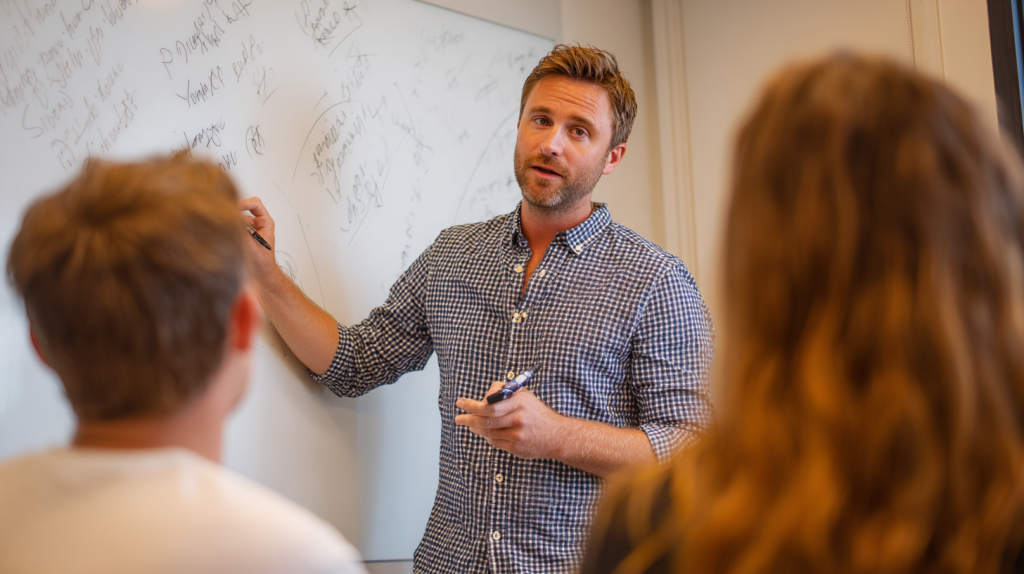Applying for an Australian Partner visa can be one of the most exciting, yet stressful, steps in your journey together. Many couples quickly discover how complex the process can be, with strict evidence requirements, detailed forms, and long waiting periods. That’s where a migration agent/immigration lawyer can make all the difference.
A qualified migration agent for your Australian Partner visa can guide you through each stage with clarity and confidence. They’ll help you prepare the right documents, strengthen your relationship evidence, and avoid costly mistakes that could delay your application. With expert help, you can save time, reduce stress, and focus on what truly matters, building your life together in Australia. Let’s explore 5 key benefits of using a Migration Agent for your Australian Partner Visa!
Key Takeaways:
- Agents improve approval chances by spotting gaps, organising evidence, and tailoring submissions to decision-makers’ expectations.
- Professional agents save time and reduce stress by managing forms, deadlines, and communications with the department.
- Using an agent can be cost-effective compared with refusals, appeals, or repeated applications.
- Agents provide strategy for complex issues like prior refusals, sponsorship problems, or long-distance relationships.
- Our team brings Department of Immigration experience and practical insights from hundreds of partner visa cases.
- Agents act as your advocate, communicating clearly with officials and protecting your interests throughout the process.
- Even straightforward cases benefit from a professional review to avoid preventable mistakes and delays.
Applying for a Partner Visa is one of the most important — and complex — steps in your immigration journey. At Sellanes Clark Immigration Law Specialists, our experienced team helps couples avoid costly mistakes and achieve faster approvals. Visit our website to learn how expert guidance can make your visa process stress-free.

Understanding the Partner Visa Process
The partner visa pathway is usually a two-stage journey. A temporary visa first, then a permanent visa later. Decision makers look for consistent, credible evidence that your relationship is genuine and ongoing. Processing times vary. Onshore applications are generally quicker than offshore applications, and timeframes can stretch from about 13 months to over 20 months depending on case complexity. Offshore applications can range from 14 months to 26 months.
Mistakes or gaps in evidence cause delays and may lead to refusal. In my practice I’ve seen applications delayed for months because applicants missed simple documents, like joint bank records or clear photos. A focused review early on can save you time and money under the Migration Act and its rules.
Overview of Partner Visa Types
You’ll most commonly meet the partner visa stream through either an onshore pathway (subclass 820/801) or an offshore pathway (subclass 309/100). The onshore pathway lets you stay in Australia while the Department decides the outcome. The offshore pathway starts from outside Australia and leads to entry and later permanent status.
- Onshore (820/801): apply while you are in Australia, then wait for the permanent decision.
- Offshore (309/100): apply from abroad, travel to Australia after the initial grant, then receive permanent residency later.
- Prospective Marriage (subclass 300) is an option if you plan to marry in Australia within 9-15 months.
- Evidence types include joint finances, shared residence, social proof, and personal statements.
- After you lodge, you must watch for requests for more information and respond quickly.
| Onshore (820/801) | Apply from inside Australia; temporary then permanent; typical wait 13–20 months depending on backlog. |
| Offshore (309/100) | Apply from outside Australia; initial entry permission then permanent grant; timelines often 14–26 months. |
| Prospective Marriage (Subclass 300) | For fiancés who will marry in Australia within 9-15 months; leads to partner visa pathway after marriage. |
| Key Evidence | Joint bank accounts, lease or mortgage, photos, travel records, written statements from friends and family. |
| Common Practical Points | Health and police checks needed; sponsor obligations apply; costs vary with current visa fees and counsel fees. |
Common Challenges in the Application Process
Proving a genuine relationship is the single biggest challenge you will face. Inconsistent statements, gaps in the timeline, or sparse evidence of cohabitation raise questions. Visa officers often ask for clarification, and long answers without supporting documents lead to slow outcomes. I review hundreds of files and see relationship evidence problems in around a quarter of cases.
Health and character checks create separate hurdles for some applicants. A medical issue or an unclear police record can add months to processing time. Sponsors must also meet obligations. Past sponsorship breaches or outstanding debts to the Department can block approval. Preparing these items before you apply prevents surprise refusals and long waits.
To reduce risk, collect specific examples like a dated lease with both names, multiple joint bank statements spanning 12 months, photos across different years, travel itineraries showing shared trips, and short statements from at least five people who know your relationship. If you work with us, we will show you how to arrange this evidence into a clear timeline that decision makers can follow.
Benefit 1: Expertise and Experience
You get a lot more than just paperwork when you hire a migration agent/immigration lawyer. You get years of focused practice with partner visas. With over 20 years inside and alongside the Department, I know which documents help and which create questions that slow or block a decision.
That expertise translates into practical gains for you. In dozens of cases I’ve handled, clear file structure and targeted evidence cut processing time and avoided requests for more information that often lead to stress and extra cost for applicants.
Navigating Complex Requirements
Partner visas need proof across many areas including shared finances, living arrangements, social life and care for each other. You might have one strong item, like joint tenancy, but gaps in other areas can trigger concerns. I look for consistent patterns in your evidence so the decision maker sees your relationship as whole, not a list of separate documents.
For example, a client once had no joint bank accounts but had shared bills, travel photos, and a joint lease. We framed those documents to show ongoing commitment and provided a timeline. The result was approval without a lengthy evidence request. You get this benefit when an agent knows what to collect and how to present it.
Staying Updated on Immigration Law Changes
Immigration rules and departmental policies change often. A practice I enforce in my firm is daily monitoring of Department updates and policy notices. That means your application uses the current standards, not rules that applied a year ago.
When the Department changes a policy or guidance, even small wording shifts can affect which evidence answers a concern. I recently updated our partner visa templates after a policy notice clarified how cohabitation is assessed. This saved a client from a likely request for more information.
At our firm, we rely on official updates, professional networks, and training for my team so you benefit from timely, practical changes. That active monitoring helps you avoid outdated advice and reduces the chance of a refusal that costs time and money.
Even a strong relationship can face visa challenges if your evidence or timing isn’t right. With over 20 years of immigration experience — including decades inside Australia’s Department of Immigration — Carlos Sellanes and his team provide strategic, accurate support every step of the way. Find out how we can help by visiting our website today.

Benefit 2: Improved Chances of Approval
You increase your odds of approval when the application matches what decision-makers expect. A migration agent/immigration lawyer spots gaps that commonly trigger refusals and fixes them before you lodge.
In practice, that means clearer evidence, fewer contradictions, and fewer requests for more information. I see applications succeed more often when those issues are addressed up front.
Understanding the Decision-Making Criteria
Decision-makers look for proof that your relationship is genuine and ongoing. They check things like shared finances, joint living arrangements, messages and travel together, and consistent personal statements. You should provide clear, dated examples that show day-to-day life as a couple.
Officers also test credibility by looking for contradictions and unexplained gaps. They follow the Department’s policy and the Migration Act when assessing visas, so small inconsistencies can become problems. An experienced Migration Agent knows which details attract attention and how to present them so you won’t be tripped up.
Crafting a Strong Application
Start by organizing your evidence in a simple, logical way. Use a contents page, a short timeline of your relationship, and labelled evidence folders. You should include certified copies, translations, photos with dates, joint bills, and written statements from family or friends.
Then build a clear narrative that explains unusual facts. If you lived apart for work, show communication logs, travel records, and reasons why the separation didn’t break the relationship. I often prepare a concise relationship statement that ties every piece of evidence to the story you need officers to accept.
For example, a client had long periods apart for work. We provided call records, travel receipts, shared bank transfers, and three sworn statements from close friends. The officer accepted the coherent timeline and the application progressed without extra questions. This kind of preparation gives you a measurable advantage.
Benefit 3: Stress Reduction
Handling Paperwork and Timelines
You avoid the mountain of forms and evidence that come with a partner visa. We give you a clear checklist that breaks the application into about 30–50 items, so you know exactly what to gather and when. In one case, that checklist cut follow-up requests from the Department from three rounds to one, saving my clients months of back-and-forth.
We also manage key dates so you don’t miss deadlines that can delay or complicate your stay in Australia. We track medicals, police checks and sponsor documents and send reminders when something expires. This reduces the chance you pay extra fees or need a reapplication, which can cost you time and thousands of dollars.
Serving as Your Advocate
You get someone who speaks for you with the Department and other agencies. Our team drafts focused submissions when facts are unclear, explain unusual circumstances, and arrange certified evidence like translations or statutory declarations. For example, I once prepared a detailed statement and supporting bank records that helped a client keep their partner visa process moving despite an overseas separation.
When things get tricky, we push for sensible outcomes. I’ve negotiated with visa officers to accept alternative evidence and lodged timely responses that prevented refusals. In one matter we secured a favourable internal review within three months after lodging a clear, evidence-based submission.
Beyond paperwork, advocacy means emotional relief. You don’t have to repeat painful personal details or chase phone calls. I often act as the buffer, so you can focus on your life while we handle the technical conversations and keep you updated at every step.
Benefit 4: Cost-Effectiveness
Paying for a migration agent/immigration lawyer often looks like an extra cost at first. When you add up the time, repeated fees, and stress of fixes after a refusal, professional help usually pays for itself. Typical migration agent/lawyer fees range from about AUD 2,000 to AUD 6,000 depending on complexity. By comparison, the visa application charge and related third‑party costs can be several thousand dollars more if you need to reapply or fix problems later.
I see this every week in my practice. Clients who invest early save months and often thousands of dollars. That saving comes from smarter document gathering, correct form completion, and targeted evidence that decision makers want to see. When you factor in lost work hours, extra medicals, and reapplication charges, using an agent becomes a cost-effective choice for many couples.
Avoiding Refusals and Reapplications
A refusal means more than disappointment. It usually means you must pay another application charge and wait longer for a final outcome. If your evidence is inconsistent or a key form is wrong, the Department can refuse and you will start over. That restart can add months and cost you thousands in new fees and extra legal help.
In my files, one couple who lodged without professional review faced a refusal for missing relationship evidence. They ended up paying an additional AUD 4,500 in application and advisory costs and waited a further 12 months. By contrast, clients who used our pre-lodge review avoided that second fee and the delay. I recommend you weigh the small upfront cost against the real expense of a reapplication.
Saving Time and Resources
You save time when an agent handles the admin. Gathering certified documents, chasing police checks, booking medicals and organising translations takes hours. I often see Do It Yourself (DIY) applicants spend 40–60 hours on these tasks. With an agent, that work is directed, checked, and lodged correctly the first time.
There are also hard costs you avoid. Medical exams and police checks can each cost between AUD 150 and AUD 800. If an application is refused, you may pay for new medicals and fresh background checks again. By getting it right first, you avoid duplicate bills and stress.
Practically, we run a pre-lodgement audit for every case. We review the key evidence and flag weak areas before lodgement. That step reduces follow-up requests from the Department and cuts the number of rounds you must answer to, saving you both time and money.

Benefit 5: Personalized Guidance
You get advice that fits your life, not a one-size-fits-all checklist. We assess your exact situation — work history, time together, previous visas, family ties — and build a plan that targets the real issues decision makers will look for. In some cases a small piece of extra evidence, like a joint lease from the first year you lived together, can make the difference between approval and a request for more information.
My team and I balance what you can afford with what will most improve your chances. We often map out a clear evidence list of 12–25 items, show you how to present them, and set realistic timelines so you know what to expect.
Tailoring Applications to Specific Situations
If you have prior visa refusals, short cohabitation, or a long-distance relationship, the way you tell your story matters. I once worked with a couple separated by work who had only lived together for two years. We created a relationship timeline, organised eight supporting affidavits from friends and family, and supplied shared financial records. The file was approved after one final clarification from the Department.
When you work with us, you’ll get document lists and scripts for statements that match your case. For example, if one partner has limited joint bank accounts, we show how to use other proof including shared bills, travel records, photos with dates, and consistent social media posts. Small, well-structured evidence often outweighs large but disorganised bundles.
Ongoing Support Throughout the Process
Once your application is lodged, you still need guidance. We monitor the file, respond to departmental requests, and update your paperwork if law or policy changes. That active oversight often shortens processing time and avoids unnecessary requests for more documents.
When questions come from the Department, we draft clear replies that focus on what decision makers need to know. In one example, a simple clarification about living arrangements cut six weeks off an otherwise stalled case. You avoid guessing what to say and risk making statements that cause doubt.
We also coach you for any interviews or character checks, prepare plain-language witness statements, and keep a checklist so nothing is missed. This steady support gives you confidence and reduces the chance of delays or refusal.
Conclusion
With this in mind, you should see the clear benefits of using a migration agent/immigration lawyer for your partner visa. An agent brings expert advice, cuts the risk of mistakes, and boosts your chance of approval.
You pay for strategy and advocacy, not just paperwork. If your case is complex or you want certainty, an experienced agent protects your application and your future together.
Your Partner Visa deserves more than guesswork. Since 2003, Sellanes Clark Immigration Law Specialists has helped thousands of couples secure their future in Australia with confidence. To discover how our team can simplify your Partner Visa application and maximise your chance of success, visit our website now.
FAQ
Q: Why should I hire a migration agent/immigration lawyer for a partner visa?
A: A migration agent/lawyer brings experience with partner visa rules, reduces errors, and helps prepare a strong application. They use checklists, evidence strategies and timing plans that save clients time, stress, and avoid costly delays or refusals.
Q: How do migration agents improve my chances of approval?
A: We know what decision makers look for and how to present relationship evidence clearly. My team tailors statements, organises documents, and addresses potential issues upfront to give your application the best realistic chance of approval.
Q: Aren’t migration agents/immigration lawyers expensive? Are they worth the cost?
A: An agent/lawyer often prevents refusal and reapplication fees, saving money long-term. We also speed processing and reduce stress, which can be financially and emotionally valuable if a visa delay disrupts work or travel plans.
Q: Can I prepare my partner visa application myself?
A: Yes, some people apply successfully, but DIY risks include missing evidence or legal nuances. Agents review complex timelines and prior visa history, so when issues exist our guidance often changes outcomes and avoids expensive mistakes.
Q: What specific services does a migration agent provide?
A: We assess eligibility, build a tailored evidence plan, draft persuasive statements, lodge applications correctly, monitor progress, and respond to requests from immigration. We also prepare clients for interviews and advise on bridging visas and sponsorship matters.
Q: How long does it take to see benefits from hiring an agent?
A: Benefits appear immediately through fewer errors and clearer documents. Within weeks you get organised evidence lists and a lodgement-ready file. Over months you gain faster responses and guidance through each stage until final decision is reached.
Q: How do agents handle tricky or complex partner visa cases?
A: We identify weak points early, collect supporting evidence, and craft legal arguments that address concerns. Our specific team draws on department experience to test likely objections and present mitigation plans, which improves outcomes in complicated sponsorship or previous-visa issues.
Author Bio
Carlos Sellanes is the founder and principal of Sellanes Clark Immigration Law Specialists, an Australian firm established in 2003. Before launching the practice, Carlos spent more than two decades with Australia’s Department of Immigration, gaining unmatched insight into migration law and policy. Today, he leads a team recognised among the Top Ten Immigration Law Firms in the Asia-Pacific, offering expertise across skilled, family, and corporate visa categories. Through his blogs, Carlos shares practical updates and professional guidance to help clients navigate the complexities of Australian immigration with confidence. Learn more about Sellanes Clark Immigration Law Specialists.



